Thursday, July 2, 1998 continued
Continued south on the Klondike Highway - much beautiful scenery on the approach to White Pass - stopped for numerous pictures.
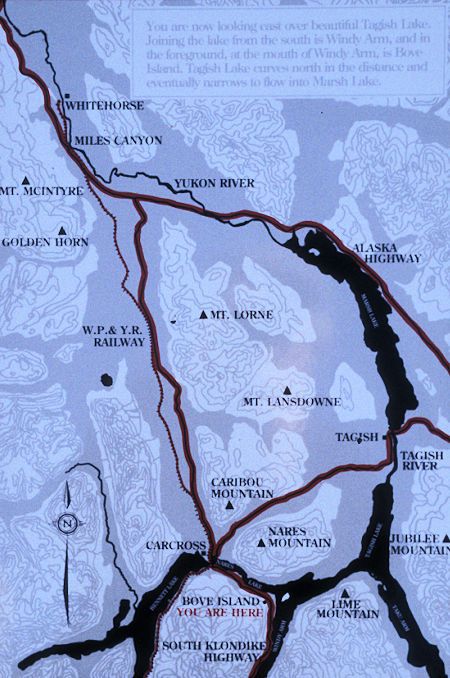
Tagish Lake area map, Yukon Territory
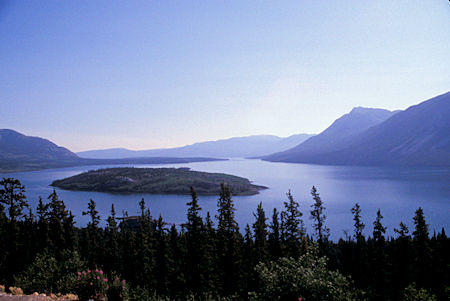
Bove Island on Windy Arm of Tagish Lake, Yukon Territory
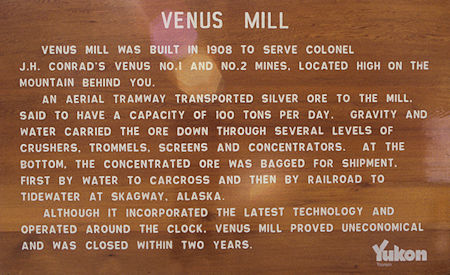
Venus Mill sign
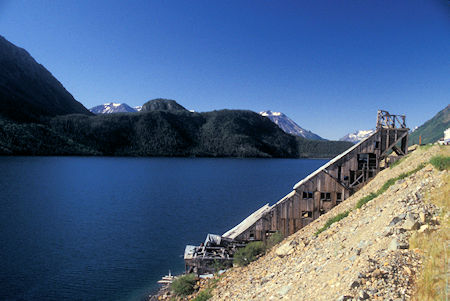
Venus Mill 1998 on Windy Arm of Tagish Lake, Yukon Territory
John Conrad dreamed of making his Windy Arm district silver mines the best on the continent and a state-of-the-art concentrating mill was part of that dream. The Venus Mill, built in 1908, eased the high cost of shipping silver ore out of the territory.
Gravity pulled a line of ore-filled tipping buckets 460m down an aerial tramway cable from Venus Mine to the mill. Belt-driven mill machinery crushed and ground the ore into a powder. Mineral concentrate, floated out of the crushed rock by chemical means, was dried, bagged and shipped by steamboat to the railway at Carcross.
Conrad spent a fortune on his dream until 1912 when he was forced into bankruptcy. A new company, Yukon District Gold, leased the Venus claims and they ran the mill for a short time. New equiment was installed before the mil re-opened to run between 1918 and 1920. At peak production, the mill produced 10 tons of silver ore concentrate per day. The Venus Mill did not operate after 1920
More information in this Venus Mill brochure (PDF) and this 2015 website article Exploring the Venus Silver Mine Mill.
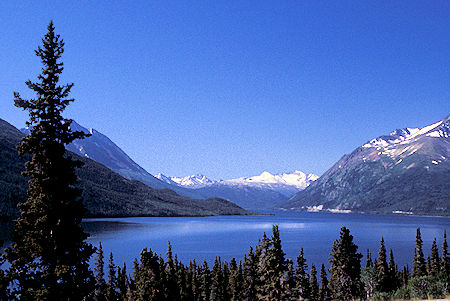
Tagish Lake, Yukon Territory
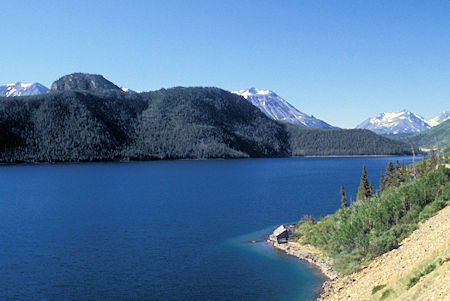
Windy Arm of Tagish Lake, Yukon Territory
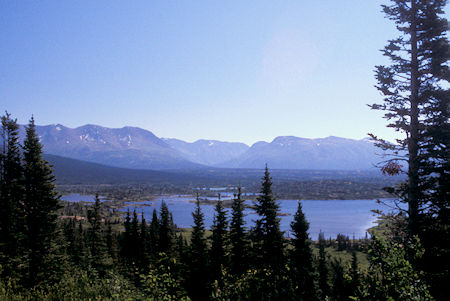
Tushi Lake, Yukon Territory
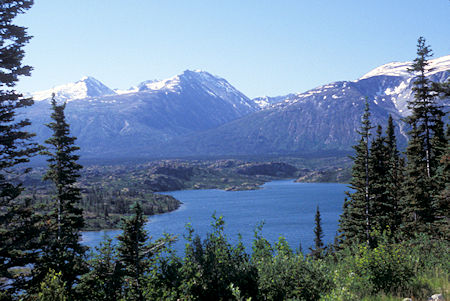
Bernard Lake, Yukon Territory
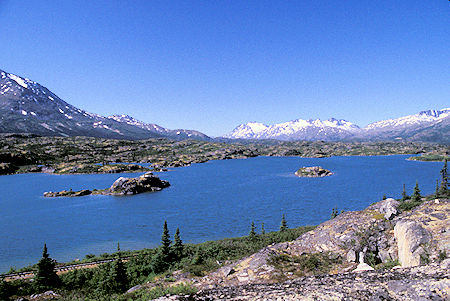
Bernard Lake near Fraser, British Columbia
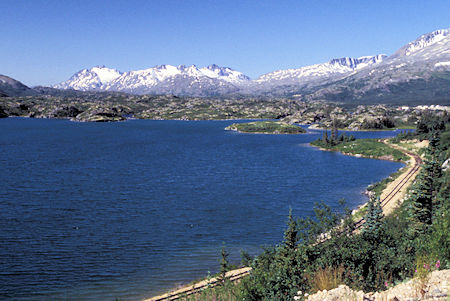
Bernard Lake near Fraser, British Columbia
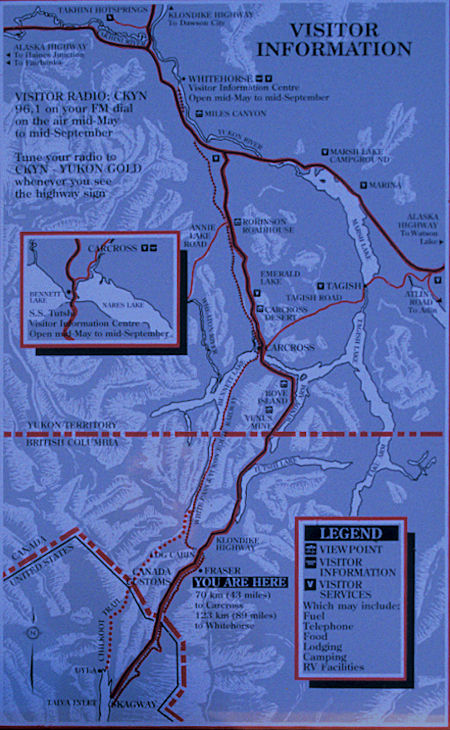
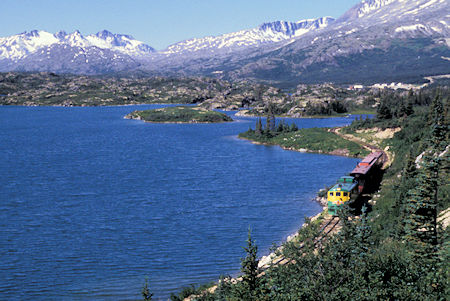
Bernard Lake near Fraser, British Columbia
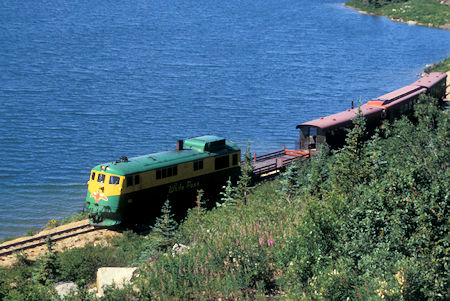
Bernard Lake near Fraser, British Columbia
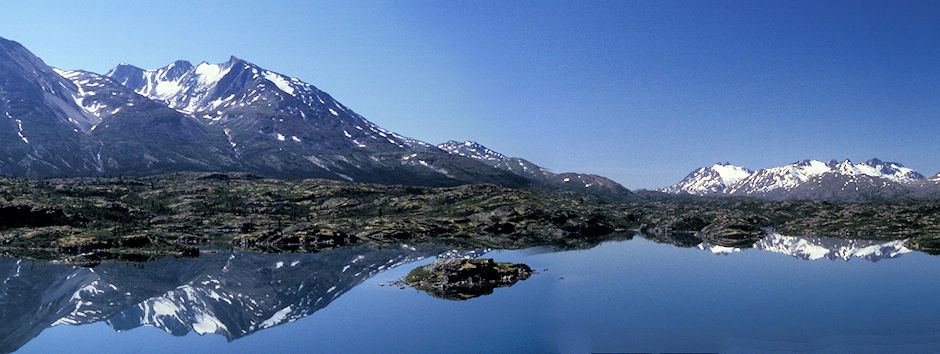
Bernard Lake near Fraser, British Columbia
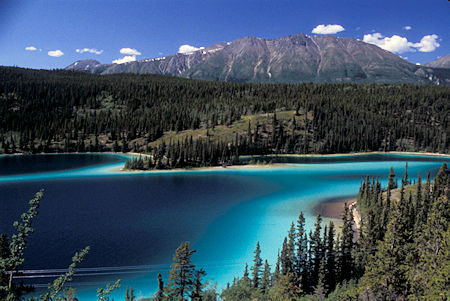
Summit Lake, mixing of glacial and non-glacial waters, British Columbia
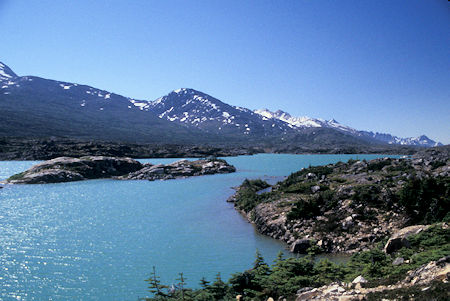
Summit Lake, British Columbia
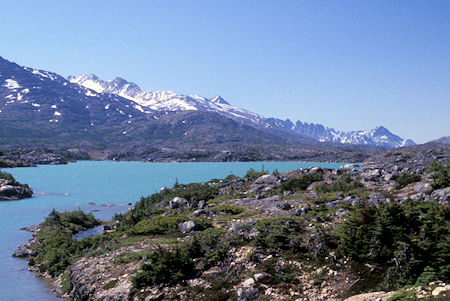
Summit Lake, British Columbia
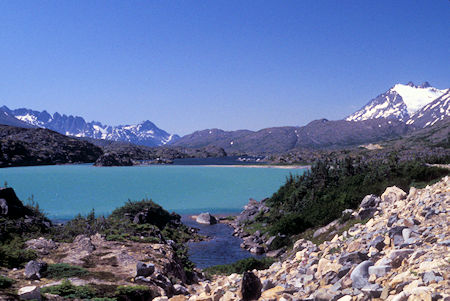
Summit Lake, British Columbia
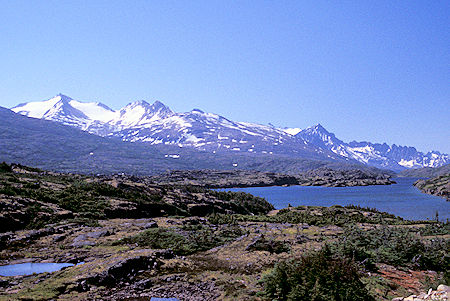
Scene near Alaska/Canada border, British Columbia/Alaska
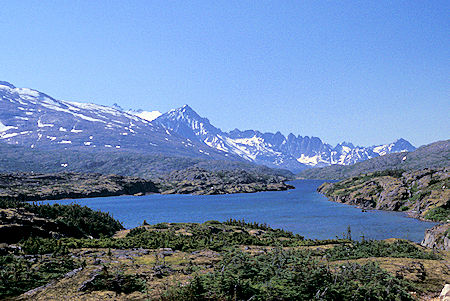
Scene near Alaska/Canada border, British Columbia/Alaska
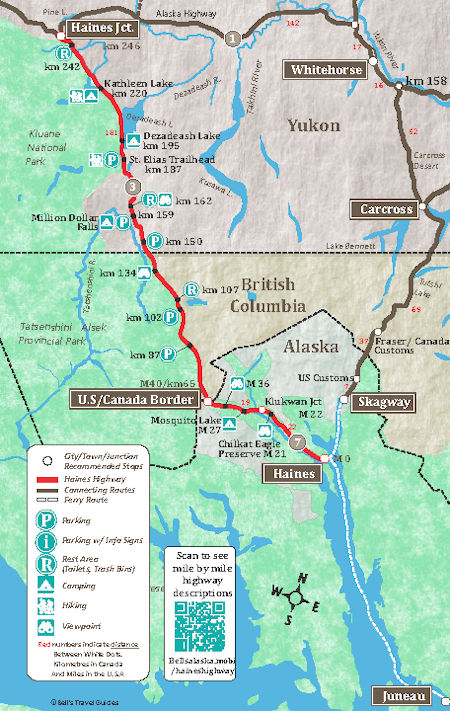
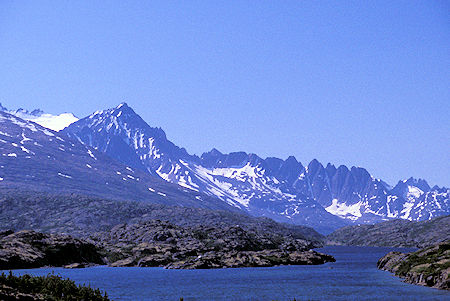
Scene near Alaska/Canada border, British Columbia/Alaska
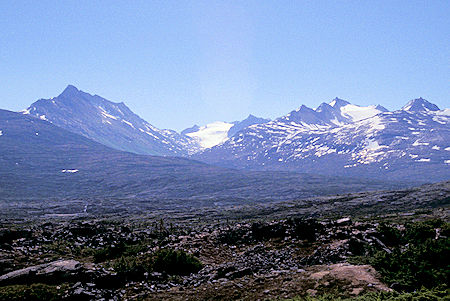
Scene near Alaska/Canada border, British Columbia/Alaska
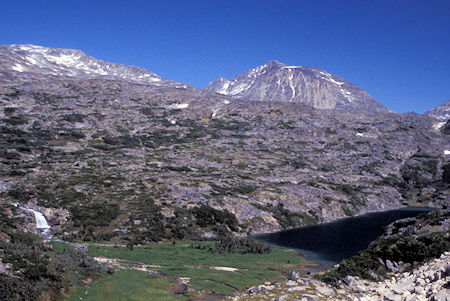
Scene near Alaska/Canada border, British Columbia/Alaska

Alaska border sign, British Columbia/Alaska
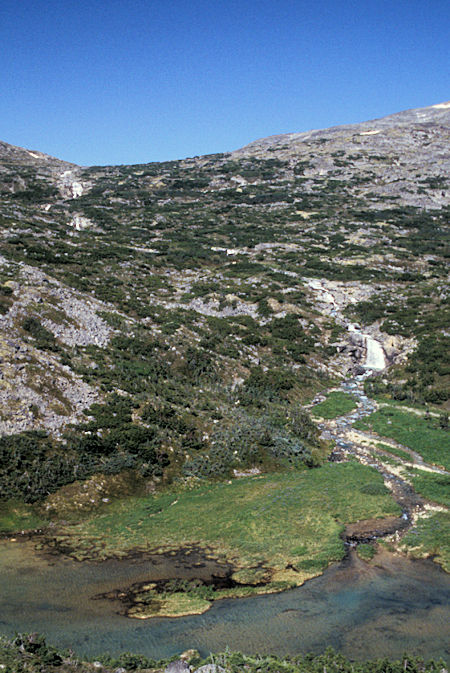
Scene near Alaska/Canada border, British Columbia/Alaska
The Canada/US border is on White Pass. The scenery down to Skagway is not as interesting.
Arrived in Skagway, AK about 1 p.m. Pacific. (Alaska operates on Alaska time which is an hour earlier - 12 noon).
I was surprised that vehicle traffic isn't a problem - at least at this time of year - parking was available on the street most anywhere.
There were two cruise ships and a giant ferry in port. Skagway was busy with tourists from the boats.
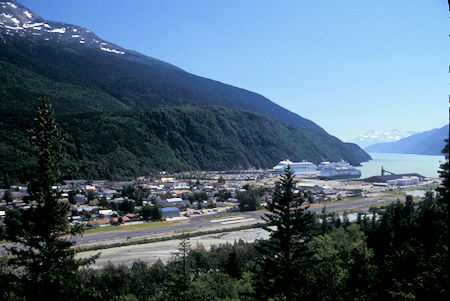
Skagway, Alaska
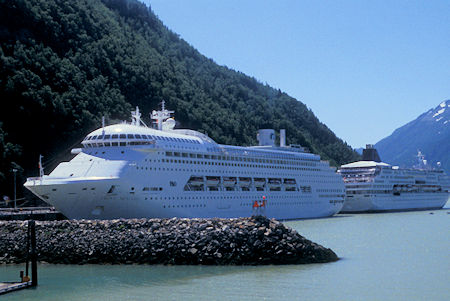
Cruise Ships, Skagway, Alaska
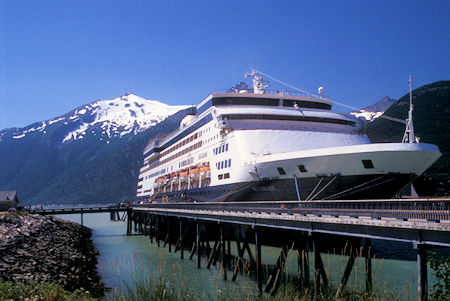
Ferry, Skagway, Alaska

Snow plow, White Pass and Yukon Railway, Skagway, Alaska
The White Pass and Yukon Railroad was running two trains with many cars - the trains are pulled up the pass by diesel engines but there was a steam engine that pulled cars from the cruise ship loading area to the edge of town where a diesel took over. Lots of people taking the ride.
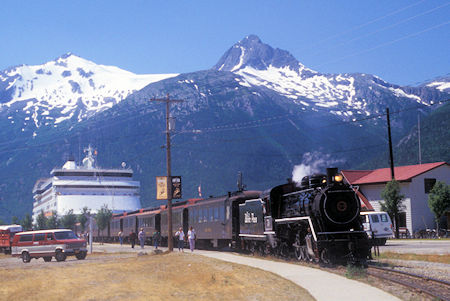
Passenger Train, White Pass and Yukon Railway, Skagway, Alaska
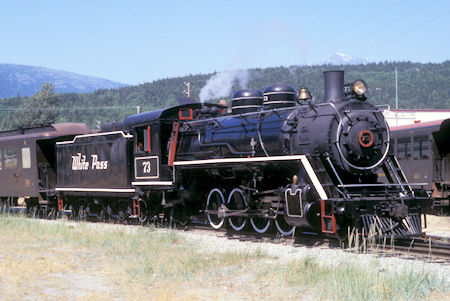
Passenger Train, White Pass and Yukon Railway, Skagway, Alaska
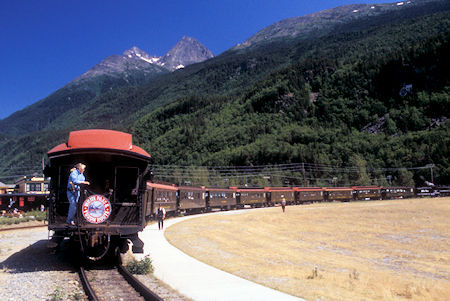
Passenger Train, White Pass and Yukon Railway, Skagway, Alaska
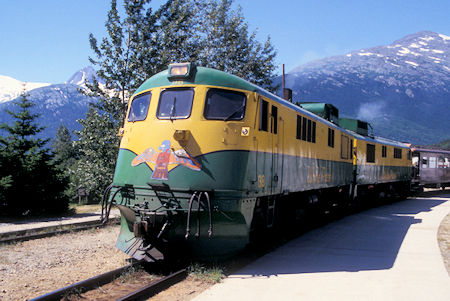
Passenger Train, White Pass and Yukon Railway, Skagway, Alaska
The Klondike Gold Rush was a migration by an estimated 100,000 prospectors to the Klondike region of the Yukon, in north-western Canada, between 1896 and 1899. Gold was discovered there by local miners on August 16, 1896, and, when news reached Seattle and San Francisco the following year, it triggered a stampede of prospectors. Some became wealthy, but the majority went in vain.

To reach the gold fields, most prospectors took the route through the ports of Dyea and Skagway, in Southeast Alaska. Here, the Klondikers could follow either the Chilkoot or the White Pass trails to the Yukon River, and sail down to the Klondike.
The Canadian authorities required each of them to bring a year's supply of food, in order to prevent starvation. In all, the Klondikers' equipment weighed close to a ton, which most carried themselves, in stages. Performing this task, and contending with the mountainous terrain and cold climate, meant those who persisted did not arrive until summer 1898. Once there, they found few opportunities, and many left disappointed.
Information about the Klondike Gold Rush.
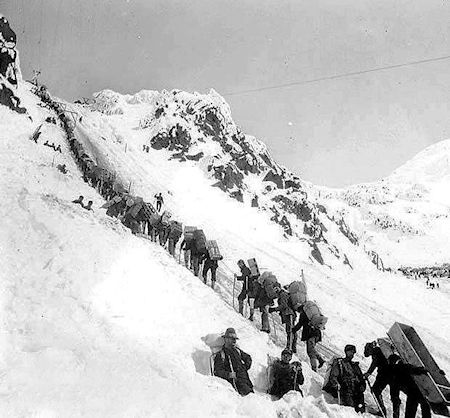
Prospectors ascending the Chilkoot Pass, 1898
Downtown has a lot of historic buildings and much of downtown is part of the Klondike Gold Rush Historic Park run by the National Park Service.
Lots of "tourist trap" stores to spend your money in. I walked around town taking pictures, etc.
Decided to drive out to Dyea, AK where the Chilkoot Trail trailhead is - along with a campground. However, they had the road closed because they had a forest fire in the area.
Returned to town and found a motel room - Wind Valley Lodge. I hit it lucky as some days they are full (usually a bus load) - and they pickup some when a ferry comes in.
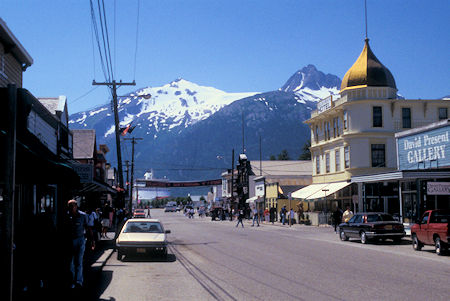
Downtown Skagway, Alaska
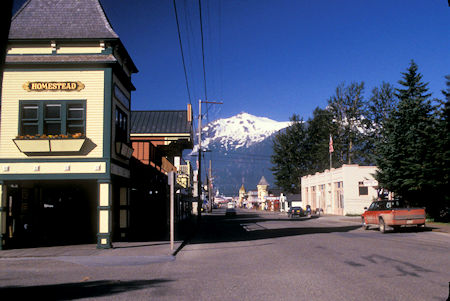
Downtown Skagway, Alaska
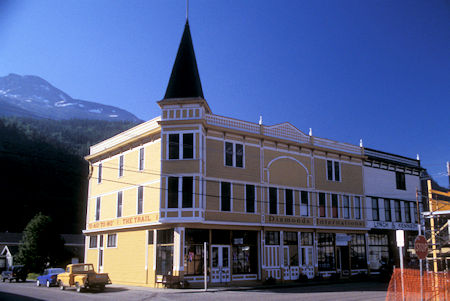
The Trail Inn & Pack Train Saloon, Downtown Skagway, Alaska
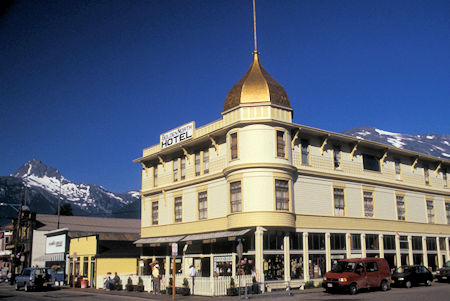
Golden North Hotel, Downtown Skagway, Alaska historic building
Friday, July 3, 1998
Clear and Sunny day. Walked around Skagway some more to see the historic places and take a few pictures. Was very quiet without all the cruise ship tourists from yesterday. Checked out the Skagway Museum - nice history of the area.
Visited the Gold Rush Cemetery and nearby Reid Falls.
Use of the cemetery stopped about 1908. The early town had a "good guy" named Reid and a "bad guy" named "Soapy Smith". One day they got in an argument and shot each other at the same time. Smith died immediately, Reid 12 days later.
The town went all out to honor Reid - some 1000 showed up for the burial and they erected a large nice monument over his grave - and named the nearby waterfall for him.
They forgot about Smith - who continued to lay on the dock where he had met his end. Some visitors arriving on a boat complained about having to step over the smelly body. He was also eventually planted in the cemetery. I got to hear an elegant explanation of all this by a tour guide for one of the bus tours.
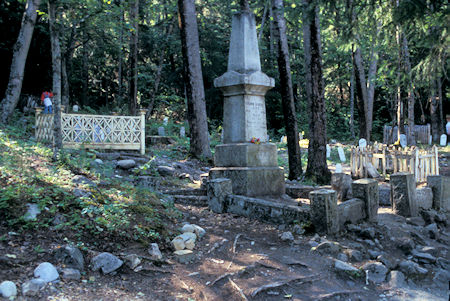
Gold Rush Cemetery, Skagway, Alaska
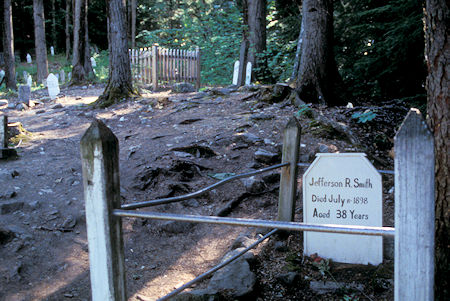
Gold Rush Cemetery, Skagway, Alaska
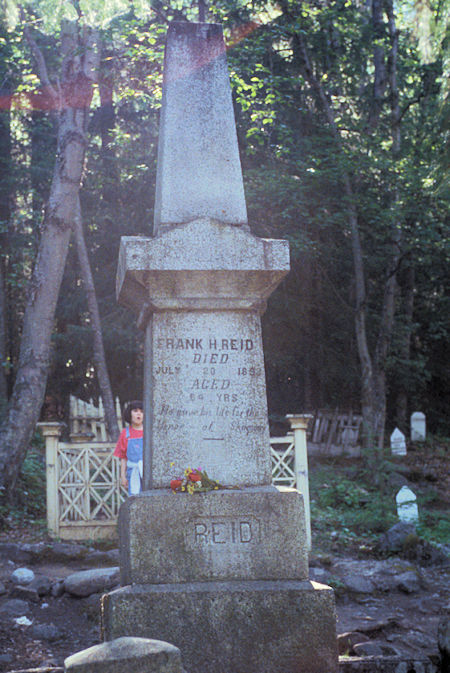
Frank H. Reid grave marker, Gold Rush Cemetery, Skagway, Alaska
Click for more Skagway, Alaska
Left Skagway about 11 a.m. and headed north back to the Alaska Highway, making a few picture stops.
The Captain William Moore Bridge is a 110-foot suspension bridge on the Klondike Highway, 17 miles from Skagway, Alaska. The bridge allows traffic to pass over the Moore Creek Gorge, which flows through a fault line. To stop the bridge from getting completely torn apart from an earthquake and movements through the fault line the bridge is only anchored at one end.
Named for Captain William Moore, a pilot, prospector, packer, trader and riverboat captain. He played an important role in the founding of Skagway and helped pioneer the route over White Pass. Captain Moore was one of the first people to realize the potential for a railroad over the pass.
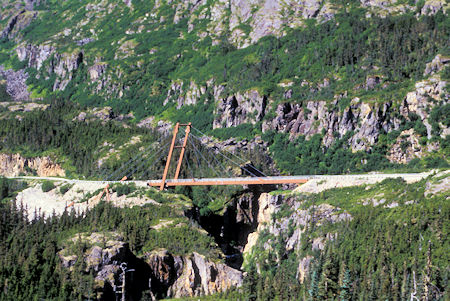
Captain William Moore Bridge, Klondike Highway, Alaska
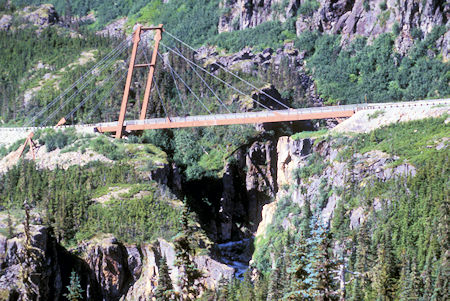
Captain William Moore Bridge, Klondike Highway, Alaska
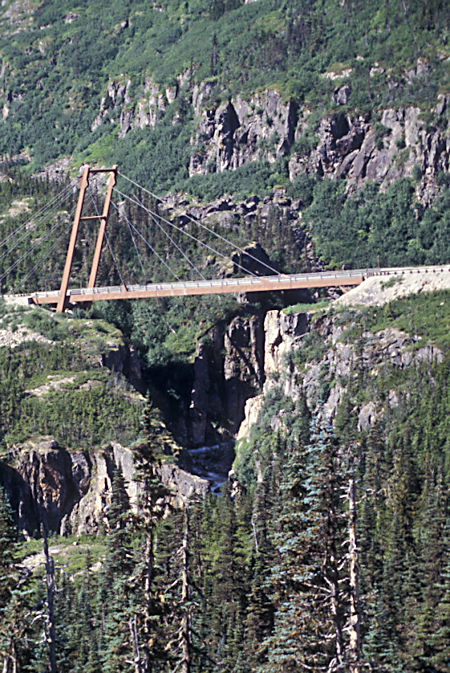
Captain William Moore Bridge, Klondike Highway, Alaska
Just before arriving at Whitehorse, YT - the capital of the Yukon Territory - I stopped at Miles Canyon on the Yukon River - a deep and fast gorge that was a problem for early river travelers.
Miles Canyon is the most dramatic natural feature near Whitehorse. The Yukon River has cut its way down through a flow of basaltic lava. The lava flowed from a vent approximately 5 miles to the south, between Golden Horn and what is now the Mount Sima ski hill, about 8.5 million years ago.
The dramatically constricted flow of the river through the canyon caused fish, salmon in particular, to pool above and below it, and the first people in the area started taking advantage of that thousands of years ago. Tools found nearby have been dated to 2,500 years ago, but people have probably been fishing and hunting there for 8-9,000 years, arriving shortly after the glaciers retreated from the rich valley.
By the time U.S. Army Lt. Frederick Schwatka arrived with his exploration party in 1883, First Nations people and prospectors had a well-worn trail along the canyon's rim. The first prospectors knew the canyon as Grand Canyon, but Schwatka named it after General Nelson A. Miles, who from 1881-85 was Commander of the Department of Columbia, which included Alaska.
During the Klondike Gold Rush, the North West Mounted Police established a post above the canyon, and all boats were stopped there for inspection. Only boats and people who the police felt could get through the canyon safely were allowed to continue - others had to put their gear on one of two wooden tramways that were built around the canyon.
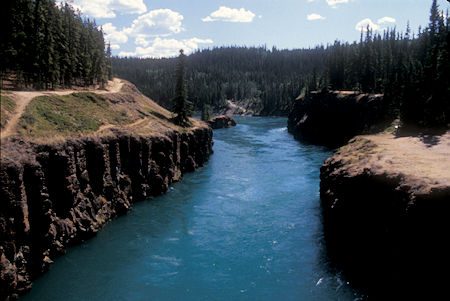
Miles Canyon, Yukon River near Whitehorse, Yukon Territory
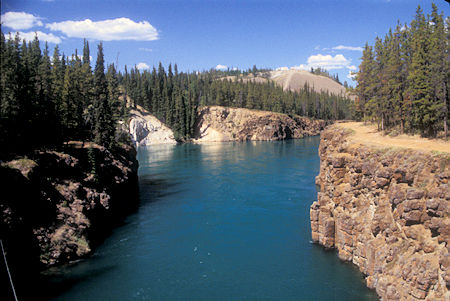
Miles Canyon, Yukon River near Whitehorse, Yukon Territory
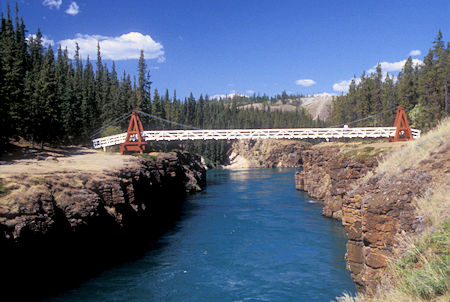
Miles Canyon, Yukon River near Whitehorse, Yukon Territory
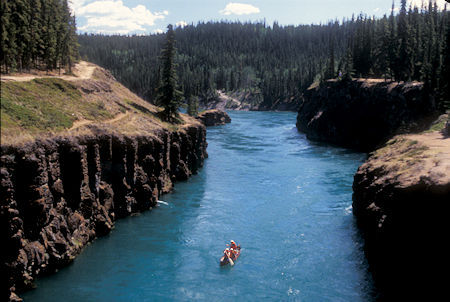
Miles Canyon, Yukon River near Whitehorse, Yukon Territory
In Whitehorse, I took the tour of the S.S. Klondike II, one of the stern wheelers that had plied the river between Whitehorse and Dawson City.
The S.S. Klondike National Historic Site represents an era of riverboat transportation. It was the sternwheeler that brought the world to the Yukon and it was the Yukon River that carried these changes.
It took 8 cords of wood to go down river, 42 cords to get back to Whitehorse upstream.
Since the boat couldn't carry 42 cords at a time, they had wood camps along the river for resupply. The fares were adjusted accordingly - something like $25 down, $40 up.
More information in this S.S. Klondike brochure (PDF).
Was an interesting tour - not quite as elegant a ship as the S.S. Moyie in Kaslo that I saw in 1997.
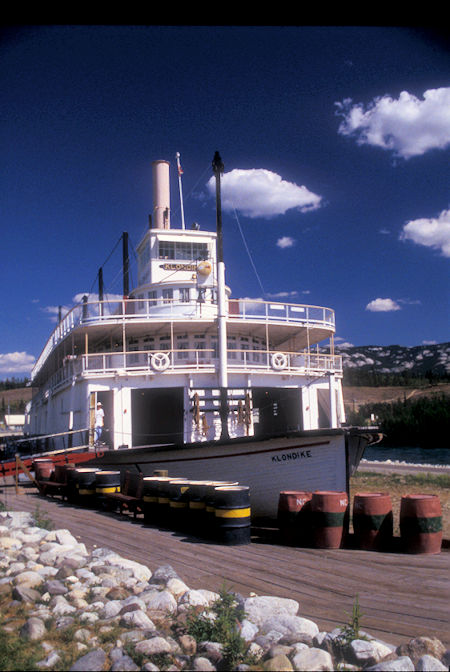
S.S. Klondike, Whitehorse, Yukon Territory
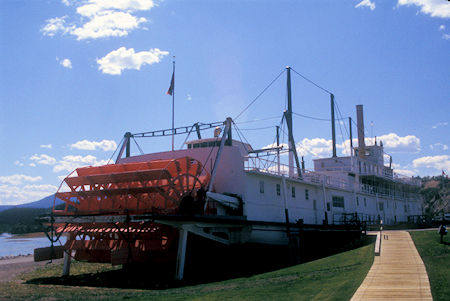
S.S. Klondike, Whitehorse, Yukon Territory
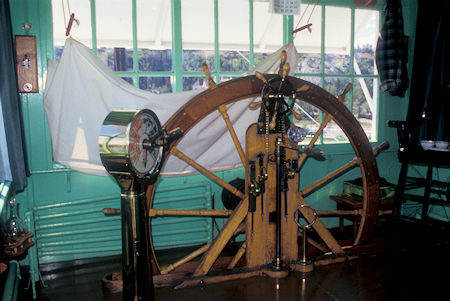
S.S. Klondike, Whitehorse, Yukon Territory
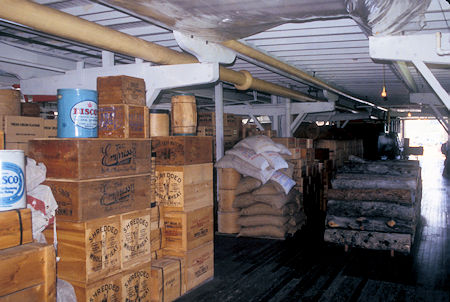
S.S. Klondike, Whitehorse, Yukon Territory
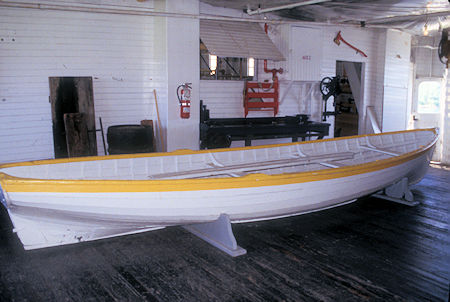
S.S. Klondike, Whitehorse, Yukon Territory
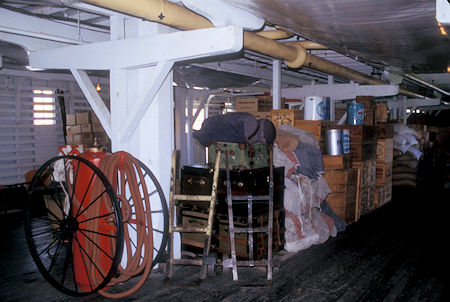
S.S. Klondike, Whitehorse, Yukon Territory
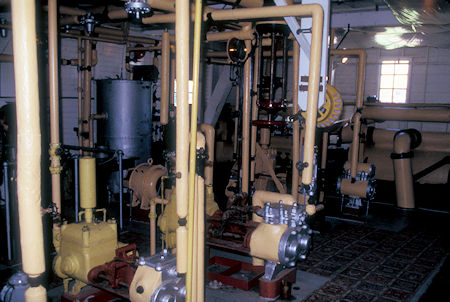
S.S. Klondike, Whitehorse, Yukon Territory
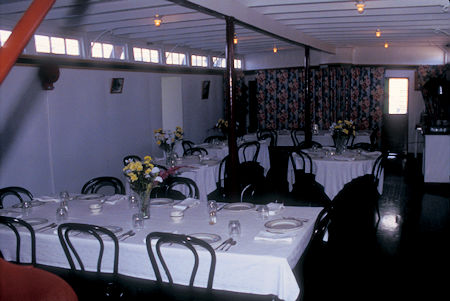
S.S. Klondike, Whitehorse, Yukon Territory
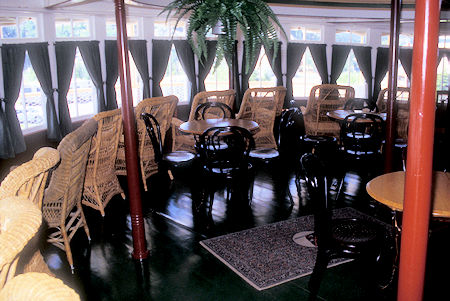
S.S. Klondike, Whitehorse, Yukon Territory
Also visited the Beringia Museum and the Yukon Transportation Museum in Whitehorse.
The Beringia Museum is a Natural History museum with displays of Mammoths and other animals. Very well done, informative and worth seeing.
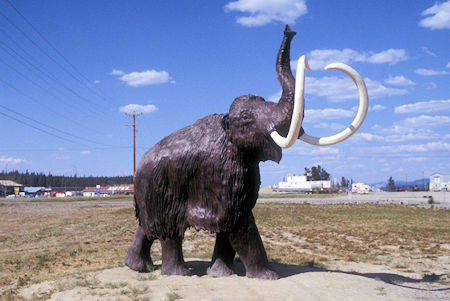
Mammoth exhibit, Beringia Museum, Whitehorse, Yukon Territory
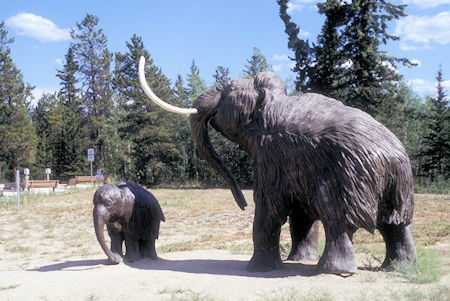
Mammoth exhibit, Beringia Museum, Whitehorse, Yukon Territory
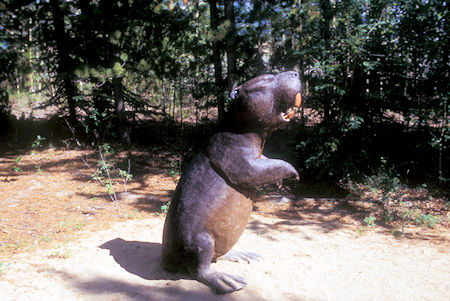
Beaver exhibit, Beringia Museum, Whitehorse, Yukon Territory
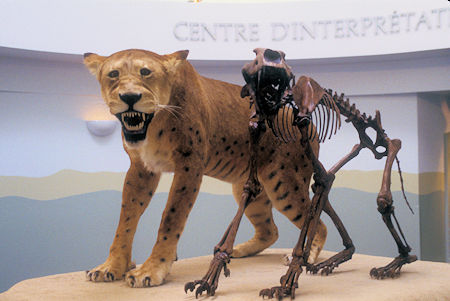
Scimitar Cat exhibit, Beringia Museum, Whitehorse, Yukon Territory
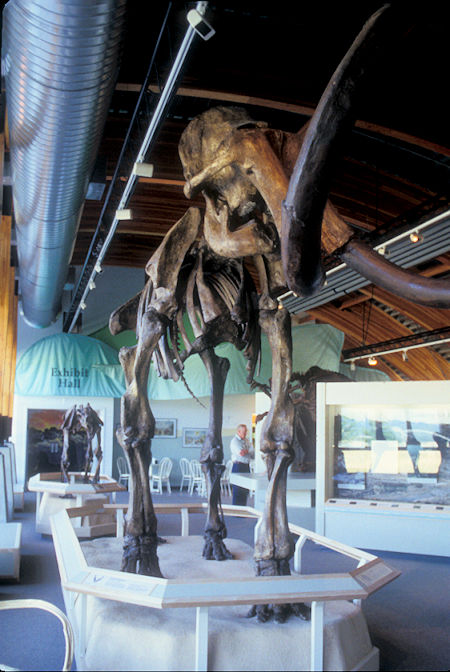
Wooly Mammoth exhibit, Beringia Museum, Whitehorse, Yukon Territory
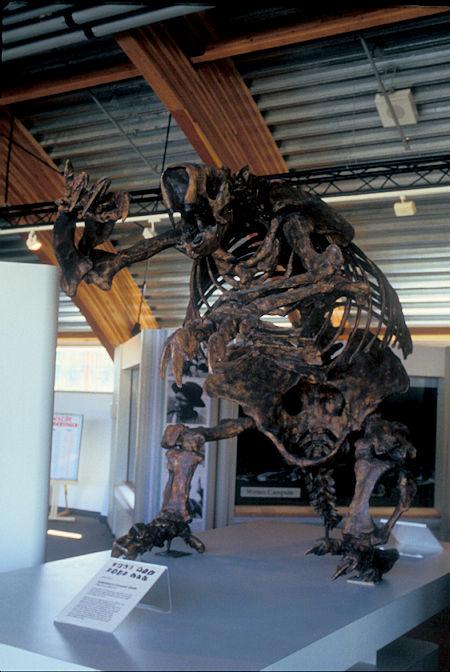
Jefferson's Ground Sloth exhibit, Beringia Museum, Whitehorse, Yukon Territory
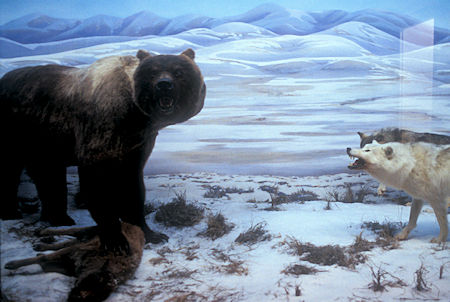
Giant Short Faced Bear and Wolf exhibit, Beringia Museum, Whitehorse, Yukon Territory
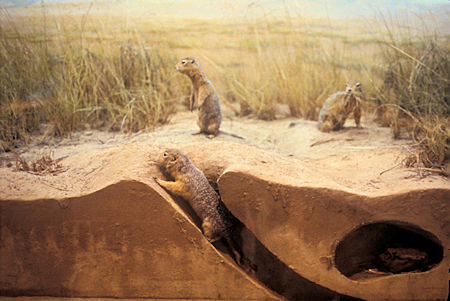
Artic Ground Squirrel exhibit, Beringia Museum, Whitehorse, Yukon Territory
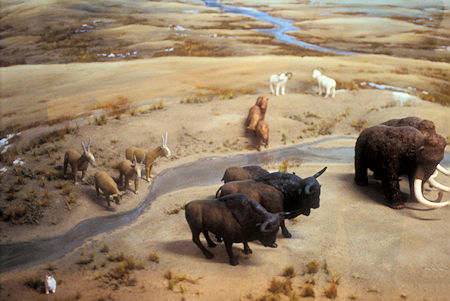
Beringia Museum, Whitehorse, Yukon Territory
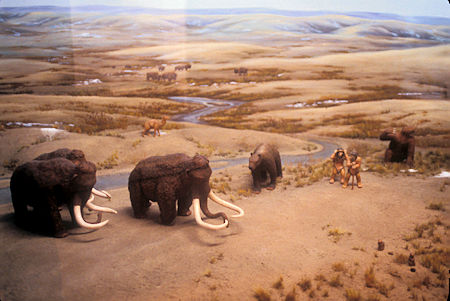
Beringia Museum, Whitehorse, Yukon Territory

Natives exhibit, Beringia Museum, Whitehorse, Yukon Territory
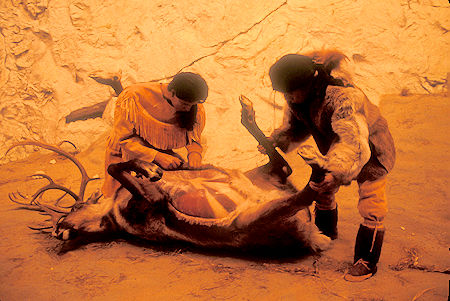
Natives exhibit, Beringia Museum, Whitehorse, Yukon Territory
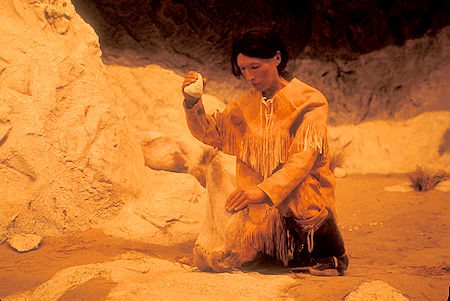
Natives exhibit, Beringia Museum, Whitehorse, Yukon Territory
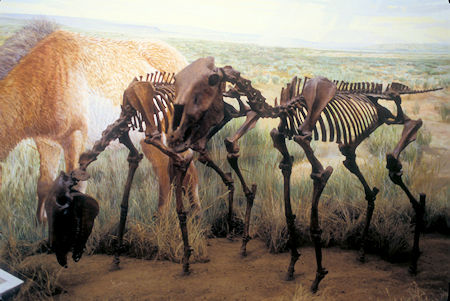
Wild Horse exhibit, Beringia Museum, Whitehorse, Yukon Territory
The Yukon Transportation Museum was also interesting and worth seeing. It covers a wide range of transportation methods.
One, an airplane called Queen of the Yukon was built by Ryan in San Diego. Ryan had started to built it when John Lindberg visited and saw it. He got Ryan to modify it to his needs and it became the Spirit of St. Louis - Ryan then started again and built the Queen of the Yukon.
The delivery of the Queen of the Yukon II on August 17, 1929 was to bring new hope to Yukon Airways; instead it brought despair. On November 2, 1929 pilot John Patterson was taking off at Mayo when tragedy struck. The Queen went down and Patterson was killed—the Yukon’s first aviation fatality.
Despite the efforts of Yukon Airways, the company could not recover and by 1930, was all but finished. The remains of the Queen of the Yukon now rest underneath the runway at the Whitehorse International Airport.
The replica Queen of the Yukon on display at the museum was commissioned by the Yukon Government for the Yukon pavilion at Expo ’86 in Vancouver. It was built by world-renowned harpsichord builder Ted Turner and his team of assistants on Pender Island, B.C.
She is made almost entirely of wood with a welded steel frame and fabric covering. The replica took nine months to complete. After its debut at Expo, this Queen of the Yukon was donated to the Yukon Transportation Museum.
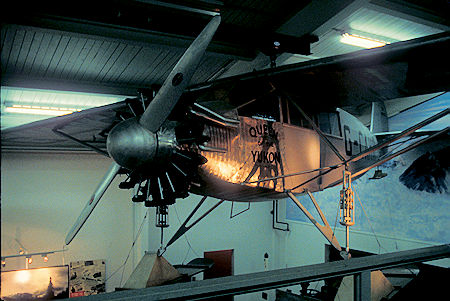
Queen of Yukon airplane, Yukon Transportation, Whitehorse, Yukon Territory
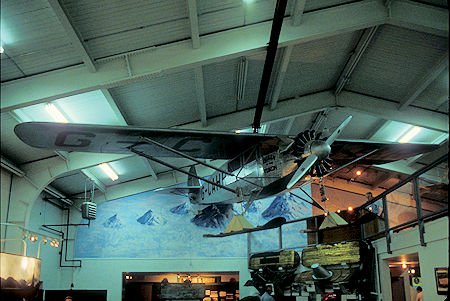
Queen of Yukon airplane, Yukon Transportation, Whitehorse, Yukon Territory
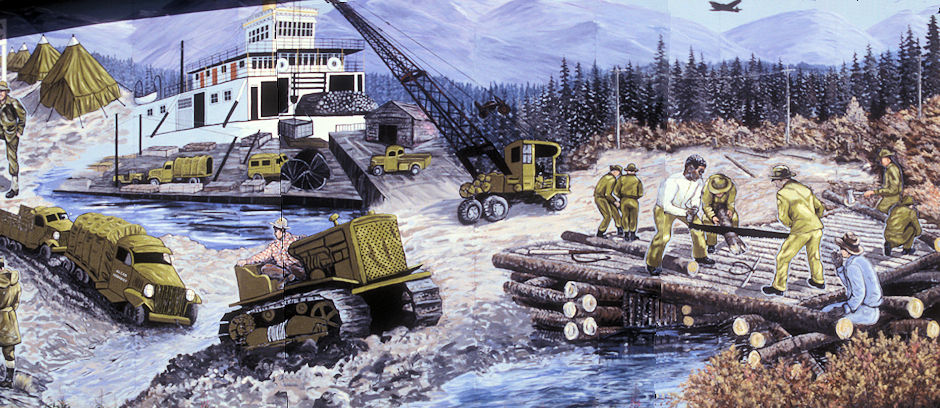
Yukon Transportation Museum Mural - Whitehorse, Yukon Territory
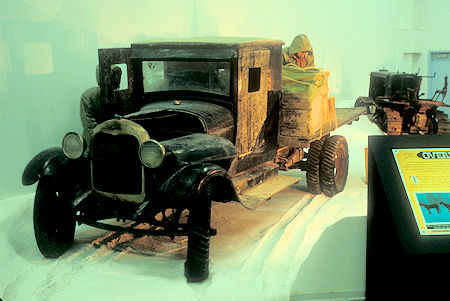
Yukon Transportation, Whitehorse, Yukon Territory
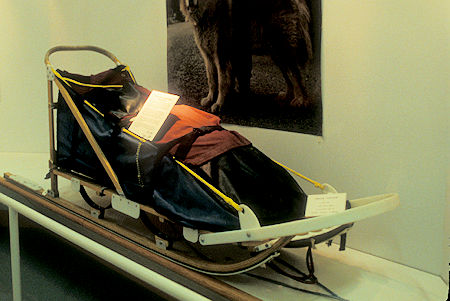
Lana DeHouse Racing Sled, Yukon Transportation, Whitehorse, Yukon Territory
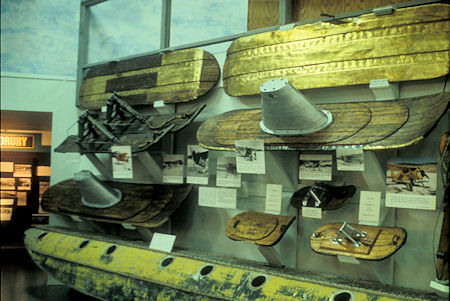
Airplane Landing Skis/Floats, Yukon Transportation, Whitehorse, Yukon Territory
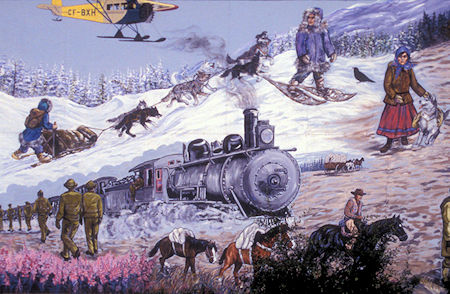
Mural at Yukon Transportation Museum, Whitehorse, Yukon Territory
Fair amount of smoke in the air from the forest fire near Skagway - and, I think there was another one north of Whitehorse. Made camp for the night at Kusawa Lake Yukon Government Campground .


